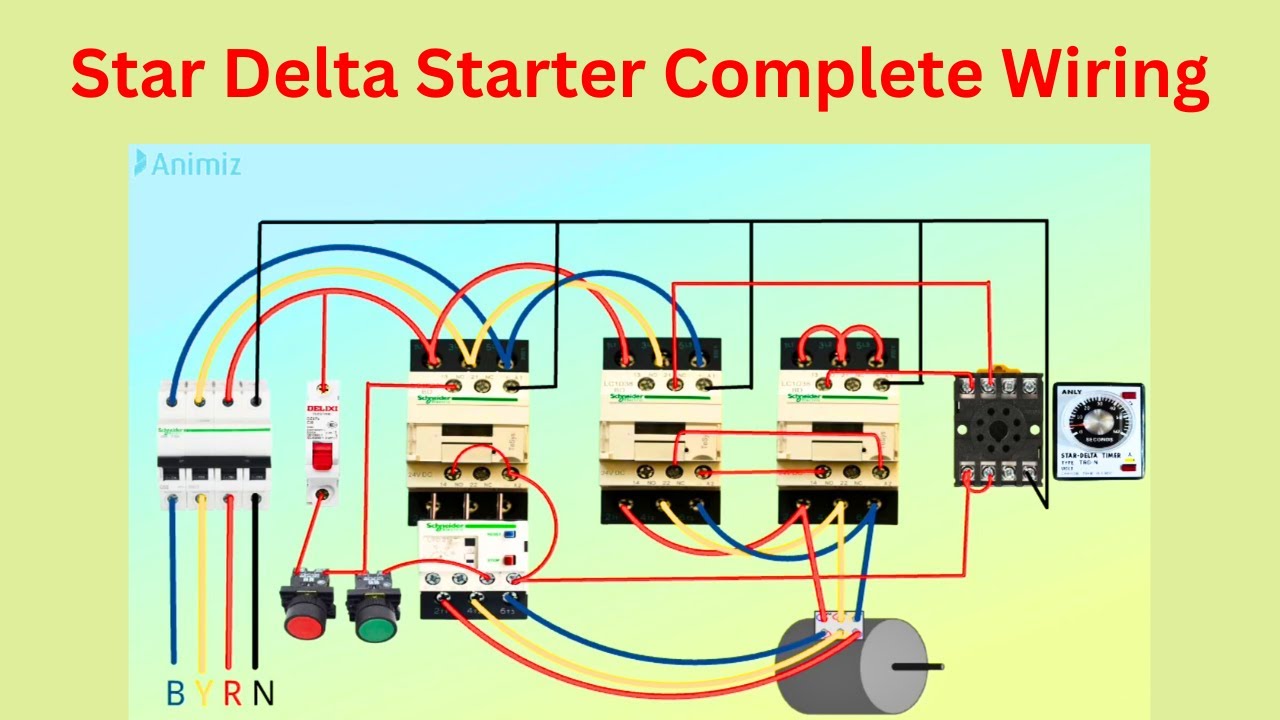Starting & Controlling of 3-Phase Motors Using Automatic Star-Delta Starter (Y-Δ)
A Star-Delta starter is an electromechanical device used to start and control the speed of a three-phase induction motor. This starter employs the star-delta (Y-Δ) method for starting the motor, which involves changing the motor’s winding connection from a Star configuration to a Delta configuration once the motor reaches a certain speed.
The Star-Delta starter includes a control circuit that typically consists of a timer, contactors, and overload relays. When the motor is started, it is initially connected in a Star configuration to reduce the starting current, which can be up to 6 times the motor’s full-load current. After the motor reaches a specific speed, the timer switches the winding connection to a Delta configuration to ensure the motor operates efficiently.
This starter is widely used in industries where high-power motors are required, such as in oil and gas, mining, and manufacturing. The star/delta starter offers several advantages, including reduced starting current, better control of inrush current, and reduced stress on the motor windings during starting. However, it also has some disadvantages, including increased cost and complexity, longer starting time, and reduced torque during starting.
In this tutorial, we will demonstrate the automatic star-delta (Y-Δ) starting method for 3-phase AC induction motors. This will include providing a schematic, power and control, PLC ladder, and wiring diagrams. We will also explain how the star-delta starter works and discuss its applications, as well as its advantages and disadvantages.
On the left-hand side, there is the main contactor with a pneumatic timer. The main contactor is always energized.
In the middle, there is the Delta contactor, which is equipped with a thermal overload for motor protection in the event that the motor exceeds the ampere rating set on the thermal overload.
On the right-hand side, there is the Star contactor, which is the first contactor to be energized with the main contactor. When the timer reaches its time limit, the Star contactor de-energizes, and the Delta contactor energizes. This allows the motor to run at full load.
Starting & Controlling of 3-Phase Motors Using Automatic Star-Delta Starter (Y-Δ)
A Star-Delta starter is an electromechanical device used to start and control the speed of a three-phase induction motor. This starter employs the star-delta (Y-Δ) method for starting the motor, which involves changing the motor’s winding connection from a Star configuration to a Delta configuration once the motor reaches a certain speed.
The Star-Delta starter includes a control circuit that typically consists of a timer, contactors, and overload relays. When the motor is started, it is initially connected in a Star configuration to reduce the starting current, which can be up to 6 times the motor’s full-load current. After the motor reaches a specific speed, the timer switches the winding connection to a Delta configuration to ensure the motor operates efficiently.
This starter is widely used in industries where high-power motors are required, such as in oil and gas, mining, and manufacturing. The star/delta starter offers several advantages, including reduced starting current, better control of inrush current, and reduced stress on the motor windings during starting. However, it also has some disadvantages, including increased cost and complexity, longer starting time, and reduced torque during starting.
In this tutorial, we will demonstrate the automatic star-delta (Y-Δ) starting method for 3-phase AC induction motors. This will include providing a schematic, power and control, PLC ladder, and wiring diagrams. We will also explain how the star-delta starter works and discuss its applications, as well as its advantages and disadvantages.
On the left-hand side, there is the main contactor with a pneumatic timer. The main contactor is always energized.
In the middle, there is the Delta contactor, which is equipped with a thermal overload for motor protection in the event that the motor exceeds the ampere rating set on the thermal overload.
On the right-hand side, there is the Star contactor, which is the first contactor to be energized with the main contactor. When the timer reaches its time limit, the Star contactor de-energizes, and the Delta contactor energizes. This allows the motor to run at full load.
























No comments:
Post a Comment